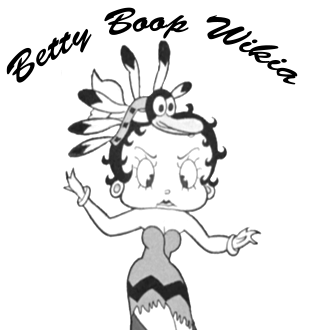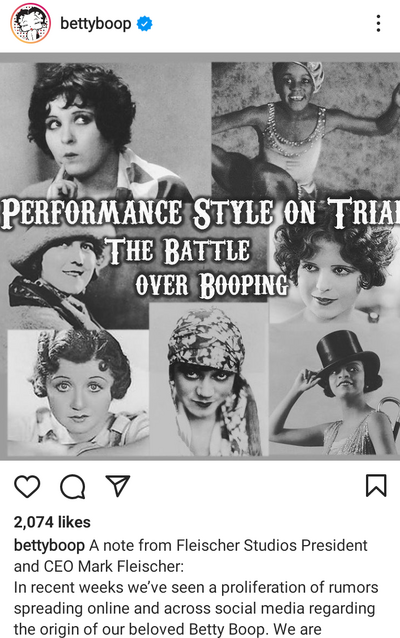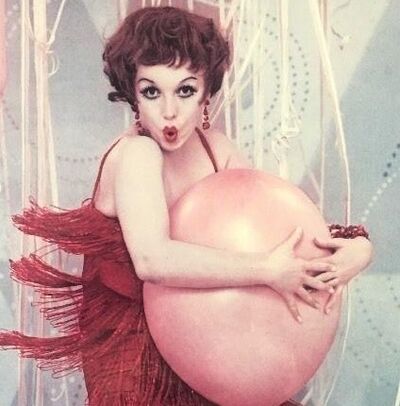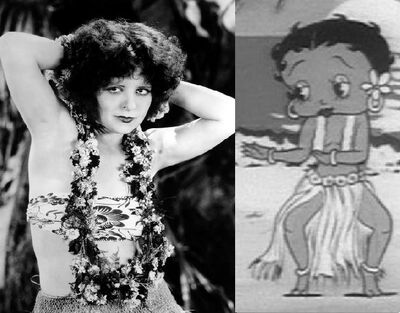Bow is the original Paramount Pictures jazz-baby, pin-up and sex-symbol. She inspired many women during the 1920s to be like her. According to Paul Ash who discovered Helen Kane and Peggy Bernier, Kane was one of the latter who attempted to emulate Bow. Bow was honored by the "WAMPAS Baby Stars" campaign by the United States Western Association of Motion Picture Advertisers in 1924. Bow is "partially" the model and inspiration for Betty Boop.[1] Much like 1980s starlet Madonna Ciccone, Bow often reinvented herself and had many different looks. Bow has been emulated by many women throughout the decades, with the most famous being Marilyn Monroe whom paid homage to her.
-
Clara Bow
| Clara Bow the It Girl |
|---|
| Clara Bow | |
|---|---|
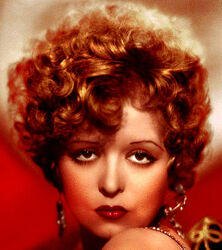 | |
|
Name |
Clara B. Beldam |
 | |
|
Name |
(Clara Bow and Betty Boop compared to one another in Hollywood on Parade No. A-8.) |
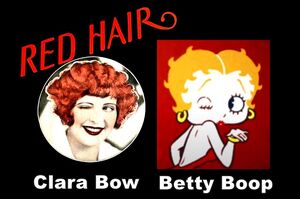 | |
|
Name |
(Clara Bow inspired Betty Boop's hair color.) |
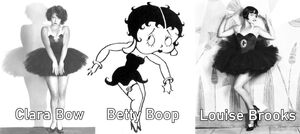 | |
|
Name |
(Clara Bow inspired Betty Boop's frilly dress.) |
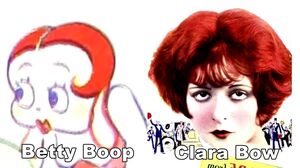 | |
|
Name |
(Clara Bow in 1928 and Betty Boop in 1931.) |
 | |
|
Name |
(Clara Bow in 1930 and Betty Boop in 1934.) |
 | |
|
Name |
(Comparison #1.) |
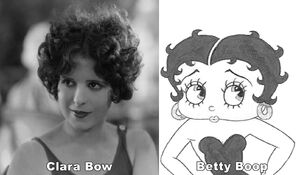 | |
|
Name |
(Comparison #2.) |
 | |
|
Name |
(Comparison #3.) |
 | |
|
Name |
(La Bow in "Hula" in 1927, and La Boop in "Bamboo Isle" in 1932.) |
Clara Bow born (July 29, 1905 - September 27, 1965) was an American actress who rose to stardom in the 1920s. It was her appearance as a plucky shopgirl in the film "It" that brought her global fame and the nickname "The It Girl". There was also a Black Clara Bow, known as Nina Mae McKinney.
Bow was known as the "It-Girl" because she had it. Bow herself did not understand it. In the 1950s, Bow felt that her favorite actress Marilyn Monroe was the "It" girl.
Elinor Glyn created the "It-factor" and explained how "It" refers to the ethereal, mystical attraction that some people possess and which makes them extremely alluring.
She was best known for her brown eyes and red hair, she was also known as "Clara Bow-Do-De-Oh-Do" and Brooklyn Bonfire. Though deemed the original vamp and sex symbol, Theda Bara came before her.
Bow grew up surrounded by violence and poverty. When the 16-year-old entered and won a magazine "fame and fortune" contest in 1921, Bow believed she had been given a second shot at life. She later became a famous personality of the mid-1920s.
A butcher knife was pressing on Bow's throat when she woke up one night in February 1922. Her mother hesitated, but Bow resisted and locked her up. Bow's mother Sarah Bow had schizophrenia. Many years later, doctors said that Bow may have inherited her mother's schizophrenia, by linking it to the night that her mother had tried to kill her.
Though Bow suffered with mental illness, she lived a normal life.
During her lifetime, Bow was the subject of wild rumors regarding her sex life, most of them were untrue. A tabloid called The Coast Reporter published lurid allegations about her in 1931, accusing her of exhibitionism, incest, lesbianism, bestiality, drug addiction, alcoholism, and having contracted venereal disease.
The publisher of the tabloid then tried to blackmail Bow, offering to cease printing the stories for $25,000, which led to his arrest by federal agents and, later, an eight-year prison sentence. After having several scandals and an affair Bow retired in 1931, and became a rancher in Nevada. Her final film, Hoop-La, was released in 1933.
When Orchestra Leader, Composer, Vaudeville Personality and Recording Artist "Paul Ash" pushed "Boop-Boop-a-Doop" girl Helen Kane forward for a performance at the Paramount Feature. Ash had Kane "emulate" his former protégé Peggy Bernier, and he had said that Kane would be the "next" Clara Bow, and that Kane would be Bow's protégé.
Which didn't turn out the same as Kane had her own gimmick. Not too long after, Ash did the same with a young Ginger Rogers, who he later influenced to imitate Kane, Rogers later ditched the "Helen Kane" gimmick and found her own style and identity. In 1958 sex-symbol "Marilyn Monroe" paid homage to Clara Bow in a photo shoot.
According to a 1930 article by gossip writer Fanny[2] the Fan of Teacups, Kane who had a tremendous following in New York was "furious" over Gloria Swanson's statement saying that any one with half an eye could see that Clara Bow the "It" girl was the one real beauty among film stars. Around that time, Kane the baby-voiced girl, grew richer to the extent of $2,500 a week. Kane at the time was "thought by many" to be quite a genius of baby-talk songs.
It should be noted that other women in the movie colony didn't think highly of Bow. Her being in public was frowned upon by rivals. Louise Brooks known as the ravishing flapper, was the only notable person to be Bow's rival and speak highly of her.
Bow appeared in an earlier the 1930 musical short Paramount on Parade, which also starred Helen Kane. Clara Bow said, she will tell you confidentiality why they call her the It Girl. Helen Kane said she would take you to her private school and teach you how to Boop-Boop-a-Doop. Bow was even once told by a interviewer that she looked similar to Helen Kane, however Bow didn't think so. This is possibly because Kane was more "plumper" in size, and had weight problems and later in her career was always referred to as "plump" or "chubby". It was also noted that Bow did not "get on well" with other female performers.
When Kane made her debut in 1928, she was more slim and petite, Whereas Bow in comparison was always sexy, slender and petite, and just like the iconic cartoon character Betty Boop was risqué. Kane in her earlier career was cited as "being pretty" but used more of the baby-doll image. She was known to be more sophisticated and classy, and more or less wore sailor costumes, frilly long dresses and bows in her hair. Whereas Bow wore sexy tight, sometimes frilly dresses, and very little attire.
A 1930 article wrote that Kane's phonograph and record training did not help her, and that Kane's voice "suffered" in comparison to Bow who gave the mixers very little trouble, and spoke plainly and naturally.[3]
Kane at one point was considered to be a "rival" of Bow, in newspaper articles from 1929 to 1930. Both Bow and Kane's names are parallel to one another, especially in articles referring to Paramount on Parade and Helen Kane Impersonation Contests, however Kane's career fizzled by 1931.
Clara Bow is often "cited" as the "original model" for Betty Boop because "Helen Kane" who Grim Natwick had used to create Betty Boop was "initially" trying to emulate Clara Bow, this has also been stated by Paul Ash in rare newspaper and magazine articles dating back to the late 1920s and early 1930s.
Bow debuted the jazz baby doll persona years before Kane was known. Kane can be seen emulating Bow. At one point Kane was considered to be Bow's rival.
Though a huge star, Bow often refused interviews, because she felt that she couldn't trust anyone to quote her correctly. Eventually, Bow started exhibiting signs of mental instability. She withdrew from social interactions and wouldn't allow her husband to go home alone himself, even though she wouldn't mingle with him either.
Bow attempted suicide in 1944 when Bell was a candidate for the US House of Representatives. Bow said in a message that she chose death over a life in the spotlight. She sought treatment at The Institute of Living in 1949 for her widespread stomach aches and frequent sleeplessness.
Psychological testing was done in addition to the use of shock therapy. While others said Bow lacked reason, exhibited bad judgment, and behaved inappropriately or even strangely, her IQ was assessed as "bright normal".
She was diagnosed with schizophrenia when it was determined that her aches were hallucinations.
When Marilyn Monroe died, it upset Bow deeply. Bow never met Monroe, but wrote that she wished she could have helped her. She also made mention of if she could pass on the crown, she would have passed it not to someone like Elizabeth Taylor but to Monroe.
Bow did not return home. Following her release from the facility, Bow lived alone until her passing. Bow lived off an inheritance valued at around $500,000 at the time of her death, spending her final years in Culver City under the continual care of a nurse, Estalla Smith.
Bow's and Louise Brooks' dresses were said to have been the inspiration for Betty Boop's frilly dress.[4]
Many decades later, in a Hollywood documentary Brooks spoke about Clara Bow. Brooks was Bow's rival in Hollywood. She said that Bow was as she called herself the real "jazz-baby" and that Bow never thought that she was pretty. Brooks felt that Bow was wonderful and marvelous.
Brooks went on to say that Bow "wasn't acceptable socially" but her husband threw parties, so she asked to invite Bow. Her husband said, "Oh, heavens no, we can't have her, she's from Brooklyn." Brooks said that everyone at Paramount said Bow was the best, but Bow knew she wasn't acceptable, and knew that.
Brooks said that Bow liked to gamble, and she said that Paramount Pictures got her in debt to them, because Bow did not understand money. Bow lost millions gambling. Both Bow and Brooks made a voice screen-test together. Bow knew all about Brooks, and they spoke about Ruth Chatterton and how she was told to improve Bow's voice. Bow told Brooks that Hollywood made her feel terrible. Brooks felt that Bow had a "nice" Brooklyn accent.
Bow was the biggest star and money-maker in Hollywood, above Greta Garbo claimed Brooks. But as soon as Hollywood lost interest in Bow, that is when Bow started to slip in her own head. Brooks said that Clara Bow did not exist off the screen, and that Bow had manufactured this whole person.
In real life, Clara Bow was a redhead.[5] Betty Boop's red hair, was based on Bow. Paramount Pictures used Bow's fame to promote Boop. The Fleischers did not admit to this. Both Boop and Bow were known for their risqué personas. Both Boop and Bow were notable for flashing. Bow had already predated Boop, by doing this in "Call Her Savage," released the same year as Betty's official debut and "Wings" released in 1927, including several other Paramount films in which Bow wore very skimpy outfits.
Arthur Jarrett Jr. the inspiration behind Fearless Fred was Bow's classmate in his eighth-grade days.
The animated character "Betty Boop" portrayed in live-action by Bonnie Poe in the 1934 Paramount short Hollywood on Parade No. A-8 is compared to Clara Bow, in the short, a waxwork of Bow alongside her husband Rex Bell in person made an appearance.
In the 1980s, Desirée Goyette was hired to voice Betty Boop in The Romance of Betty Boop. Goyette initially gave credit to Helen Kane, but she later felt that Clara Bow was the "true inspiration" behind Betty Boop. In Goyette's 2014 interview she stated, "Now Clara Bow was the original 'It' girl who represented the ultimate flapper girl of the 20s, and that she is truly who Betty Boop was modeled after."
Goyette finished up with, "If you want to know more about who Betty Boop was you need to know a lot more about who Clara Bow was. And so I would do my best Clara Bow imitation as a little girl, and never imagined that I would be doing the voice of Betty Boop on a TV show." To create Betty's persona, Goyette imitated Bow.
Quotes
- Clara Bow: "Rehearsals sap my pep. Tell me what I have to do and I'll do it." (1929)
- Clara Bow: "I feel like throwing my movie career overboard, so I could read a book in peace!" (1930)
- Clara Bow: "I'll tell you confidentiality why they call me the It Girl!" (1930)
- Clara Bow: "I couldn't trust anyone to quote me correctly." (1932)
- Clara Bow: "I talked to a newspaper man and when the story came out he had me saying, dese, dem and dose." (1932)
- Clara Bow: "I might have said 'them' that's the way people talked where I came from." (1932)
- Clara Bow: "But I don't talk the way he had me talking. Heaven knows I've had few enough advantages." (1932)
- Clara Bow: "It seems cruel to make me seem more ignorant than I am." (1932)
- Clara Bow: "Rex Bell has given me the only unselfish devotion I've ever had." (1932)
- Clara Bow: "The world saw me as a sort of moll!" (1932)
- Clara Bow: "What it didn't know was that the brazen hussy who cavorted around..." (1932)
- Clara Bow: "Was sick to death of loneliness and fear and heartache." (1932)
- Clara Bow: "I can look the world in the face again confident." (1932)
- Clara Bow: "Never go to sleep angry." (1933)
- Clara Bow: "If you have a tiff be sure to kiss and make up before going to sleep." (1933)
Fleischer Studios (2021)
Clara Bow is one of the several performers to be given tribute by the Fleischer Studios and official Betty Boop page in 2021. You can find out more by clicking "The Battle Over Booping" and following the link to the Fleischer Studios article.
Marilyn Monroe as Clara Bow
The famous Marilyn Monroe paying homage to "original" sex-symbol the "It Girl" Clara Bow. The modern "Betty Boop" was rebranded to emulate Monroe, also by "coining" Monroe's iconic poses. Though Monroe portrayed a "Boop-Boop-a-Doop" girl in Some Like It Hot, she was not portraying Betty Boop. The fictional character "Sugar Kane Kowalczyk" that Monroe portrayed, was a slight nod to Helen Kane, who was known as Sugar Kane on Broadway.
Betty Boop and Clara Bow
During the $250,000 Infringement Lawsuit with Helen Kane, producer Max Fleischer stated that his Betty Boop character bore a likeness to the "It" girl Clara Bow. Paramount would often compare Boop and Bow. Paramount gave Bow the nickname "La Bow" in reviews, not long after Betty Boop was known by Paramount as "La Boop".
Death
- Clara Bow died of a heart attack on September 27, 1965 at the age of 60.
Gallery
Trivia
- Paramount Pictures commonly compared Betty Boop with Clara Bow and they later used Bow's fame to sell Betty Boop.
- Studio executives bullied Bow, while she made them rich.
- Clara Bow is referenced in the Tijuana Sex Bible.
- Mae West and Clara Bow are mentioned as Betty's inspirations on vintage official Betty Boop merchandise from the 1990s and 2000s.
- Bow took a photo with Felix the Cat.
- Her husband Rex Bell appeared in Hollywood on Parade but Bow didn't.
- Bow's 1927 appearance in the film Hula slightly inspired Betty Boop's Bamboo Isle.
- Clara Bow was the inspiration behind Margot Robbie's character "Nellie LaRoy" in the 2022 film Babylon, the film also features a Helen Kane song.[6]
- Taylor Swift's 2024 album features a song called "Clara Bow".

